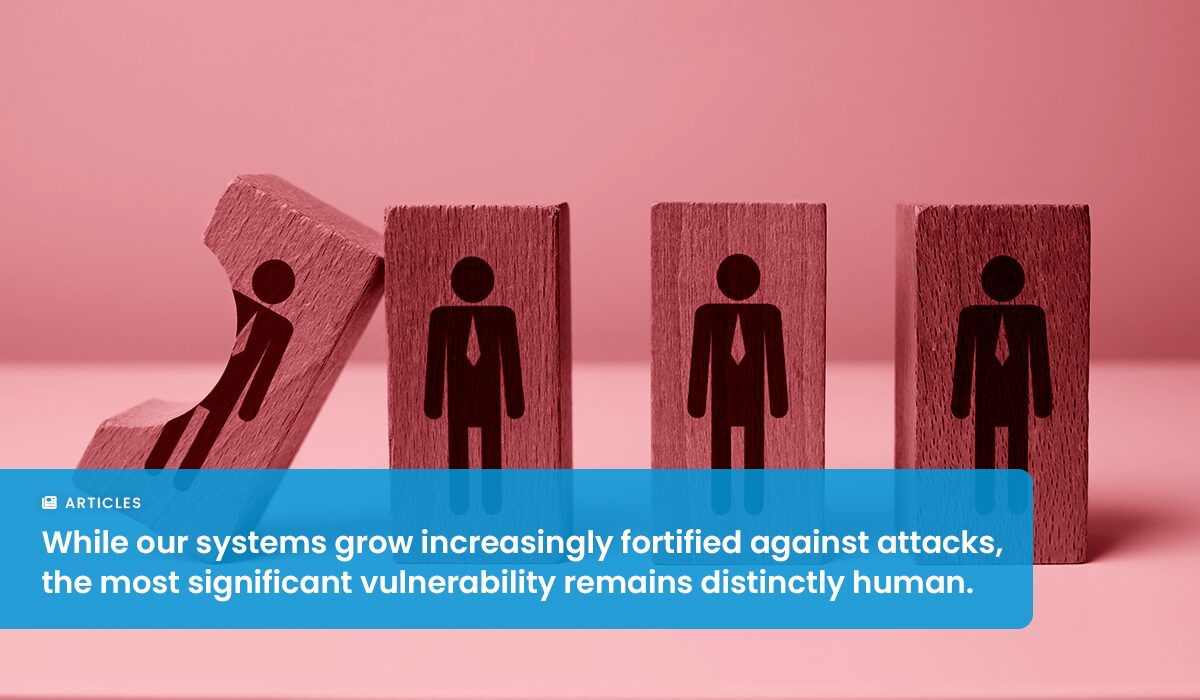In a digital world brimming with advanced cybersecurity threats targeting employees, the importance of managing human risks cannot be overstated. In fact, according to Gartner’s forecasts, by 2027, 50% of CISOs will incorporate human-centric security design practices into their cybersecurity frameworks, and by 2030, all major cybersecurity frameworks will prioritize measurable behavior change over compliance-based training, marking a departure from outdated, awareness-centric programs. This evolution marks a pivotal a shift from traditional, technology-focused security measures to those that address human risks more directly and effectively.
What is Human Risk Management?
Human Risk Management (HRM) is an approach within cybersecurity that focuses on understanding and mitigating the risks associated with human behavior. It operates on the premise that while technology can be programmed to perform with a high degree of reliability, human actions are unpredictable and can often introduce vulnerabilities into secure systems. HRM aims to address these risks through a combination of training, policy management, and the implementation of user-friendly security measures designed to align with natural human behaviors and instincts. By doing so, HRM seeks to enhance the overall security posture of an organization by reducing the incidence and impact of human errors and malicious actions.
Why Human Risk Management is Crucial
While our systems grow increasingly fortified against attacks, the most significant vulnerability remains distinctly human. The statistics illustrating this challenge are telling:
- According to Gartner, a shocking 90% of employees knowingly take actions that could put their organization’s security at risk.
- IBM’s 2023 Cost of a Data Breach Report explains that cyber-attacks initiated by malicious insiders were the costliest, at an average of USD 4.90 million–9.6% higher than the global average cost of USD 4.45 million per data breach.
- Verizon’s 2023 Data Breach Investigations Report finds that 74% of breaches have a human element involved.
These figures highlight how critical it is to address human factors in cybersecurity. In fact, human-centric security design is the best response to these issues. It goes beyond traditional security measures by reducing complicated steps and making it easier for employees to follow security guidelines. This method is about making sure security rules fit naturally with how people work, which not only helps prevent mistakes but also reduces the chances of insider threats.
Understanding Human Risks for HRM
In order to successfully address human risks, you must understand the different influences humans face on a day-to-day basis. In cybersecurity and in business, human risks are shaped by a myriad of factors, each contributing to potential vulnerabilities in their own unique ways. Let’s take a more detailed look at how social, financial, technological, political and environmental influences can impact human risks.
Social
The impact of corporate culture and peer behavior on an individual’s adherence to security protocols cannot be underestimated. For instance, in an environment where senior employees frequently ignore password policies or bypass two-factor authentication due to convenience, such behaviors may become normalized. This normalization can create a culture where security guidelines are more often viewed as suggestions rather than mandates, significantly increasing the likelihood of breaches.
Economic
Financial incentives or constraints play a critical role in shaping security practices. Organizations facing budgetary pressures might opt for cheaper, less secure solutions, or delay necessary updates and maintenance that would otherwise shore up their defenses. On the individual level, employees might use unauthorized software or devices to save time or money, inadvertently opening the door to security threats. For example, the use of personal devices for work purposes without proper security measures can lead to data leakage.
Technological
A significant risk factor arises from a lack of understanding or awareness of security tools and best practices. When employees are not properly trained or if the security solutions in place are too complex or user-unfriendly, the chances of making mistakes increase. Misconfigurations, weak passwords, and the improper sharing of access credentials are common issues that can lead to security vulnerabilities.
Environmental and Political
External factors such as regulatory changes, political instability, or environmental pressures can drastically influence an organization’s priorities and the resources allocated to cybersecurity. For example, a company operating in a region experiencing political turmoil may find its cybersecurity measures compromised as a result of infrastructure disruptions or the sudden need to change operational priorities. Similarly, new regulations might require shifts in data management practices that, if not properly managed, could expose vulnerabilities during transition periods.
By thoroughly understanding these influences, organizations can craft cybersecurity strategies that are both comprehensive and responsive to the human factors that often cause security vulnerabilities. This proactive approach is key to preventing system failures and breaches, ensuring that the organization’s cybersecurity measures are robust and adaptive to both internal and external pressures.
Components of Effective Human Risk Management Programs
To manage human risks effectively, organizations should implement comprehensive HRM programs that include:
- Security Awareness Training: Continuous education on the latest cybersecurity threats and best practices is crucial. This helps keep security awareness high across the organization.
- Phishing Simulations: Conducting regular simulations of phishing attacks and offering real-time feedback to employees who fail helps employees learn from their actions on the spot, and equips them with the skills to identify and respond to cyber threats, reinforcing theoretical knowledge with practical experience.
- Phishing Remediation: Developing effective response strategies for when breaches occur ensures that incidents are managed efficiently and lessons are learned, reducing the likelihood of future breaches.
- Policy Management: Creating clear, easily understandable policies is essential. Effective communication of these policies ensures that all employees are aware of their cybersecurity responsibilities and the implications of non-compliance.
Conclusion
The trajectory towards Human Risk Management reflects a broader recognition that technology alone cannot secure the digital landscape. It’s about creating systems that are as human-proof as possible and fostering a culture where security is ingrained in every action. By focusing on the human element, organizations across all sectors—be it healthcare, finance, or technology—can significantly enhance their security postures.
To learn more about how you can start adopting a human-centric security design at your organization, explore our Human Risk Management solutions today.
About ArmorPoint
ArmorPoint, LLC is a managed cybersecurity solution that combines the three pillars of a robust cybersecurity program — people, processes, and technology — into a single solution. Designed by cybersecurity experts, ArmorPoint’s cloud-hosted SIEM technology and extended detection and response capabilities enable businesses to implement a highly-effective, scalable cybersecurity program. With customizable pricing available, every ArmorPoint plan offers a dynamic level of managed security services that support the risk management initiatives of all companies, regardless of available budget, talent, or time. ArmorPoint is developed and powered by Trapp Technology, Inc., a Phoenix-based IT managed services provider. To learn more about ArmorPoint, visit armorpoint.com.








